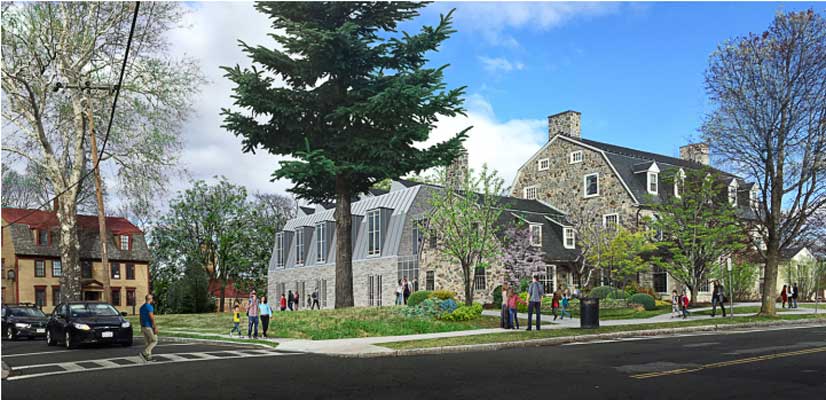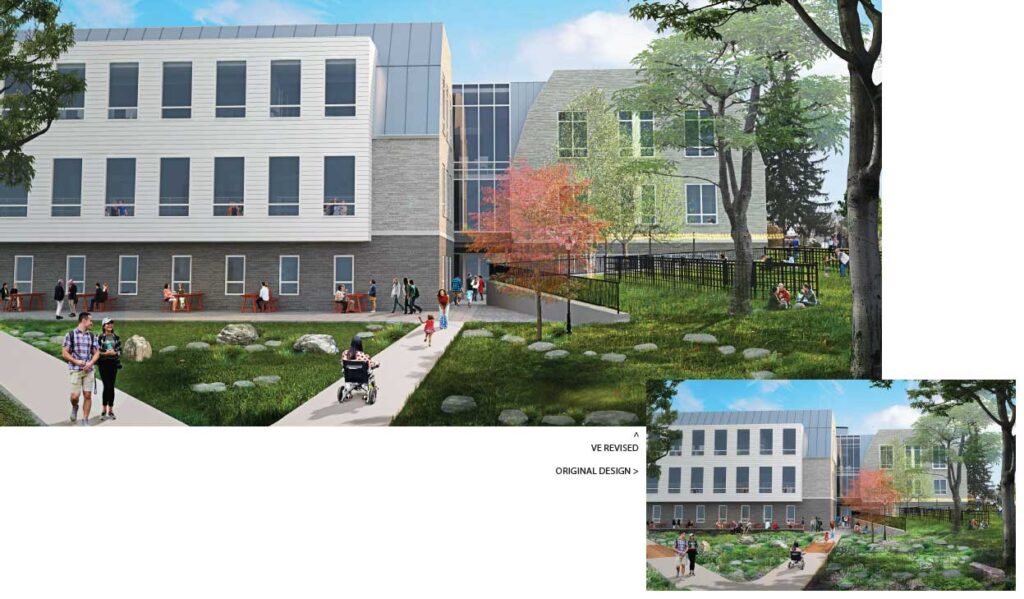State Findings Loom Large for Library Project Historic Preservation Hearings

Amherst Historical Commission to Hold Public Hearings on Aug. 22
State law requires that any building project receiving government funding submit a Project Notification Form (PNF) to the Massachusetts Historical Commission (MHC) detailing the project design so that the project may be reviewed for legal compliance. The PNF is to be completed “as early as possible in the project planning process” so that changes suggested by the MHC will not be difficult or costly to make. The MHC will determine if any historical properties are impacted, assess adverse effects, and strive to “avoid, minimize, or mitigate those effects.”
The Jones Library was listed on the state and national registers of historic places in 1991 and the MHC has declared it a historic property subject to state and federal preservation laws.
Despite concerns over adverse effects raised by members of the public as early as 2016, Jones Library Demolition-Renovation-Expansion leaders did not submit a detailed Project Notification Form until October 2023.
The MHC met its statutory obligation of assessing and describing adverse effects within 30 days. On November 22, 2023, MHC Executive Director and State Historic Preservation Officer (SHPO) Brona Simon communicated these in a letter to the preservation officer of the National Endowment for the Humanities (NEH) which has awarded the library project $1 million in funding to build a humanities center in the Library’s basement level.
This letter was sent to the Amherst Historical Commission (AHC) and Jones Library Director Sharon Sharry and has now been publicly posted on the Town website. Additional communications from the MHC elaborating on the adverse effects and explaining why the Town’s applications for historic tax credits were denied were sent to Sharry in December 2023 and April 2024.
Unfortunately for members of the public who sought a fully informed review of project compliance, the Amherst Historical Commission did not have the benefit of the adverse effects comments from the historic preservation experts at the MHC when it approved the Jones project’s application for a demolition permit in September 2023 and found compliance with the Town-Library Preservation Restriction Agreement (PRA) a month later.
Re-bid Plan Requires New Public Hearings
However, a lone construction bid received in May was $6.5 million higher than expected and was rejected. After “value engineering” to remove roughly $2 million worth of historical preservation and sustainability features from the design to make it more appealing to general contractors, the Jones Library Building Committee (JLBC) aims to put the project out for a re-bid in September. The Jones Library Trustees have committed $550,700 from their endowment to pay Finegold Alexander Architects (FAA) to prepare updated construction documents.

The design changes will require the AHC to repeat the reviews that they conducted last fall. Public hearings to evaluate the value engineered design and consider a demolition permit and PRA compliance are scheduled for Thursday, August 22 at 6:30 p.m.
This redesign will require MHC reassessment of adverse effects in the opinion of an NEH official who asked not to be quoted. It is unclear if the JLBC has resubmitted an updated PNF to the MHC to be reviewed. To date, the descriptions of design changes posted to the AHC meeting packet are limited to a memo and a set of high-level drawings prepared by FAA.
For the September 2023 demolition permit review, the AHC was provided 24 pages of detailed drawings delineating exactly which parts of the original 1927 building were being demolished. The October 2023 PRA public hearing packet included a detailed 77-page description of precisely which elements of the historic building were being destroyed or altered.
The granting of a demolition permit is governed by the Town of Amherst’s Bylaw for the Preservation of Historically Significant Buildings. Its guiding principle is “Finding that the economic, cultural and aesthetic standing of the Town of Amherst can best be maintained and enhanced by due regard for the historical and architectural heritage of the Town and by striving to discourage the destruction of such cultural assets.”
The stringent Town-Library Preservation Restriction Agreement obligates the Jones Library Trustees to maintain the building in “as good structural condition and sound state of repair as that existing on the date of this Preservation Restriction Agreement [March 2022]” and states that “this obligation to maintain shall require replacement, rebuilding, repair and reconstruction of the Building whenever necessary in accordance with The Secretary of Interior’s Standards for The Treatment of Historical Properties with Guidelines for Preserving, Rehabilitating, Restoring and Reconstructing Historic Buildings (36 CFR 67 and 68).”
Communications from the MHC obtained through a Public Record Request find that five of the ten standards that comprise the Secretary of the Interior’s Standards are being violated by the FAA design even before value engineering changes have been factored in.
For example, the MHC finds that “the Buckingham slate on the highly visible gambrel roof is proposed.to be replaced with a synthetic slate, even though the historic structures report states that Buckingham slate is still quarried and available as a roofing material. The removal of historic slate roof, which is highly visible and a character-defining feature of the building, and replacement with a synthetic slate does not meet the Standards (Standards 2 and 6).”
Finding the proposed 15,000 sq. ft. addition to be unduly large, MHC correspondence further notes that “The size, scale, and massing of a new addition all pertain to the addition’s overall volume and three-dimensional qualities. Taken together, size, scale and massing are critical elements for ensuring that a new addition is subordinate to the historic building, thus preserving the historic character of a historic property. Typically, a compatible addition should be smaller than the historic building in both height and footprint.”
The MHC adds that this problem may be avoided by reducing the size of the addition or offsetting it from the original historic building.

One might conclude from examining the legal notice for the August 22 public hearings that the town may be wishing to push through the two August 22 public hearings with little consideration of the recently disclosed MHC findings.
The notice for the demolition hearing describes it as a “Request to review changes to the updated building plans based upon value engineering concerning demolition of rear 1990s additions to the 1928 structure.” The requestors are apparently hoping that new information from the MHC on the previous design is not factored into the decision.
Similarly, the PRA hearing notice seeks to limit the scope of deliberations and avoid revisiting a possible erroneous finding by the AHC from last October. It announces “Request for changes to the site, including tree removal, changes to the building including demolition of the rear 1990s additions and replacement with new expansions and changes to the 1928 structure including new roofing material.”
Town leaders posting the legal notice may value grant money over abiding by historic preservation regulations and may be wanting the public and AHC commissioners to believe that violations of the Secretary of Interior’s standards identified by the MHC are irrelevant.
Members of the Amherst Historical Commission who will decide the public hearing questions are Chair Robin Fordham who must recuse herself from the decisions as she is employed by the Massachusetts Historical Commission, Architectural Historian Hetty Startup; Madeline Helmer, a certified Planning and Historic Preservation professional; Pat Auth, who serves as liaison to the Design Review Board, Amherst College faculty member Mikayla Rasnic; and Amherst College student Antonia Brillembourg.
The Amherst Historical Commission public hearings will be conducted over Zoom beginning at 6:30 p.m. on Thursday, August 22. Join the virtual meeting at https://amherstma.zoom.us/j/82862489988.

I hope the Historical Commission passes the library. I’m *glad* they’re doing serious cost cutting in their new plan, and I’m 100% FINE with no slate roof. We cannot preserve the historical elements, be perfectly green, and be affordable–Amherst has to choose. My vote is affordable and practical, and it seems like the library planners are getting there. I hope the Historical Commission greenlights whatever they come up with, or releases the library even further to reduce costs. Do we really need an old facade, for example? Doesn’t that just cost us extra?
Margaret, you raise an important point. However we may feel about the value of retaining historical elements, we agree that a plan should be affordable and practical. Unfortunately, the current plan is far from that. Although it makes some modest cost reductions, the current plan remains the same oversized, expensive library that would disproportionately divert town funds from other, higher-priority needs. The affordable and practical solution is to make the critical repairs that have been neglected for too long. A reasonable plan to repair and maintain the building would cost much less than the inflated quote used by proponents of the demolition/expansion project.
Ms. Sawyer states that “We cannot preserve the historical elements, be perfectly green, and be affordable–Amherst has to choose.” She is correct, but she leaves out one option, which is not to proceed with this boondoggle of a project. Does she seriously propose getting rid of the “old facade” of the Jones Library?
No slate roof? If the Amherst Historical Commission (AHC) greenlights that “Value Engineering” design change, to save $1,000,000 by replacing the historic Library’s original slate roof with asphalt shingles, they can surely kiss their entire $2,100,000 in federal grant money for this Project good-bye.
(And just where is that slate supposed to go? It is valuable. Not, surely, into some dump with the rest of the demolition debris!)
Ironically, the Library Trustees granted their historical Preservation Restriction Agreement (Agreement) to the Town precisely because of Community Preservation Act funding in 2010 and 2011 that repaired the historic slate roof, as well as the Library’s then-tottering 6 original chimneys.
The Agreement provides that the Trustees “shall not make any changes to the exterior of the Building” unless the Amherst Historical Commission has given “prior express written approval ….” See Agreement, link in article above, paragraph 3.1.
But the Historical Commission does not have a free hand in such approvals. Paragraph 4 of the Agreement provides that it “shall apply the Secretary [of the Interior’s] Standards whenever … reviewing any alteration ….” See link in article above.
What’s more, in order to qualify for their $2,100,000 in federal grants, from the National Endowment for the Humanities (NEH) and from HUD, the Trustees’ entire demolition/expansion project (Project), interior as well as exterior, must meet the Secretary’s federal Standards.
These Standards are based on Section 106 of the National Historic Preservation Act, as implemented by Title 36, Code of Federal Regulations, Sections 67 and 68.
Nonetheless, we already know that the Project as a whole fails to meet the Secretary’s Standards. How so? From the practically identical letters in December 2023 and April 2024 (links above) from Brona Simon, Massachusetts Historical Commission Executive Director. She serves also as the State Historic Preservation Officer (SHPO) for federal historic preservation/rehabilitation purposes.
Director shows why the Project’s design fails to meet five of those Standards.
As of yet, the Town has not scheduled an Amherst Historical Commission (AHC) hearing to apply the Secretary’s Standards to the entire Project. Furthermore, even if the AHC approves the Project, the AHC does not have the last word. In the end, the NEH must determine that the Project meets the Secretary’s Standards.
We know that, also, from Director Simon. Her December 2003 letter to the NEH stated unequivocally:
“Ultimately, under Section 106 [of the National Historic Preservation Act], NEH must make a determination of [adverse] effect and complete the [historical] review process.”
Copies of this letter went to Jones Library Director Sharon Sharry, and to the AHC. Thus, the Library Director has had the playbook for this game since last December. So has the AHC.
Apparently, nonetheless, the Town still expects its plans for this demolition/expansion Project to go out to bid next month. How does the Town expect its plans to be revised by then, to meet the Secretary’s Standards? Beats me.
The world would be a desolate place if everyone adopted Margaret Sawyer’s attitude towards preserving historic buildings.
Legal requirements aside, anyone wondering why it is important to protect the Jones Library’s historic facade, its Buckingham Slate roof which previous Boards of Trustees and Directors have diligently maintained, its irreplaceable handcrafted interior millwork and designer Allen Cox’s intentional and period-inspired floorplan should read local author and educator Max Page’s Why Preservation Matters (Yale University Press, 2016).
In addition to retaining the cultural memory embodied in historic buildings, Page points out, preservation is key to combating climate change.
He writes, “Saving historic places and reusing them must be a cornerstone of environmental sustainability. Nearly half of all greenhouse gases are produced in the construction, demolition, and operation of commercial and residential buildings. We need to find ways that the preservation movement can join the conservation movement to achieve more sustainable communities.”
Here’s a simple question:
What’s it called when an organization, such as elected and appointed municipal officials, as well as members of boards or committees, repeatedly ignore Massachusetts and Federal laws in their decision making?
An impartial source (Alphabet’s generative AI) suggests this simple answer:
“A criminal enterprise is a group of people with a structure, such as a hierarchy, that is involved in significant criminal activity. The FBI defines criminal enterprises as structured organizations that engage in criminal conspiracy and activity. Criminal enterprises can be legal or illegal businesses or groups that are used as a base for criminal activity. The goal of criminal enterprises is often financial gain with minimal risk of being caught.”